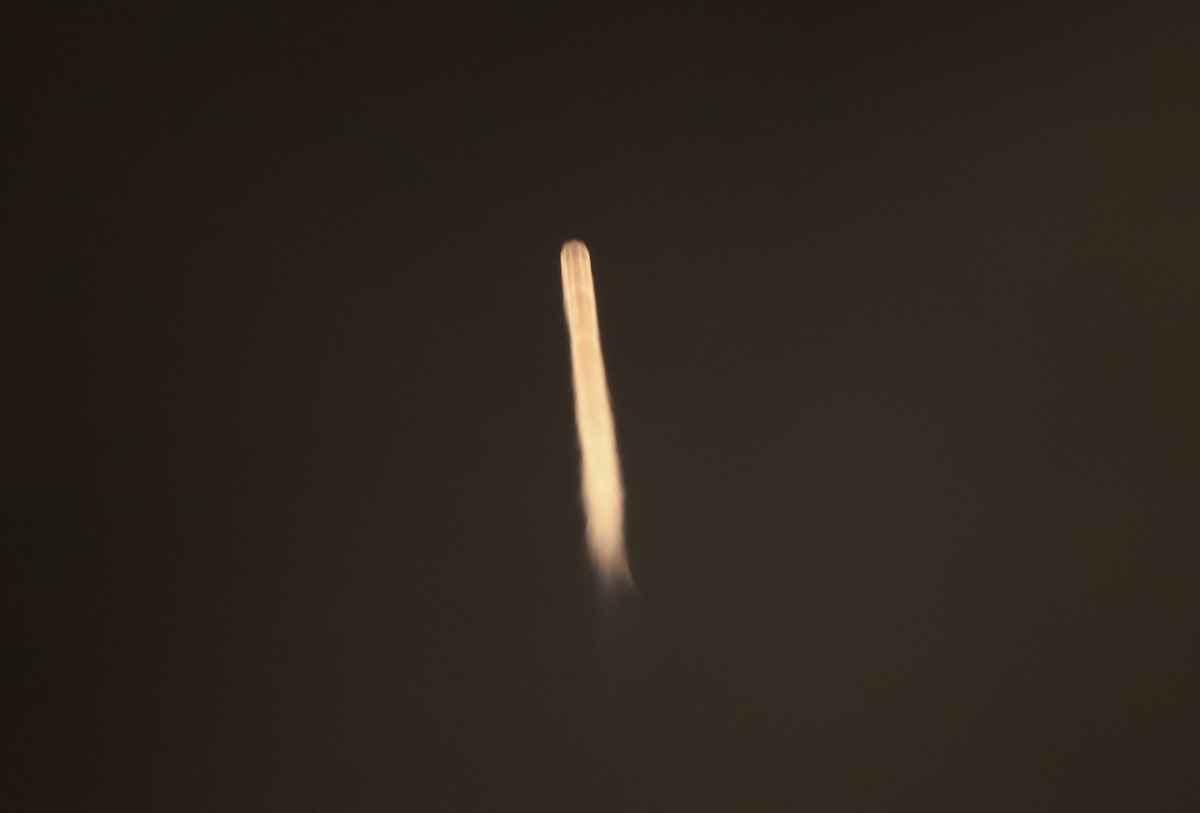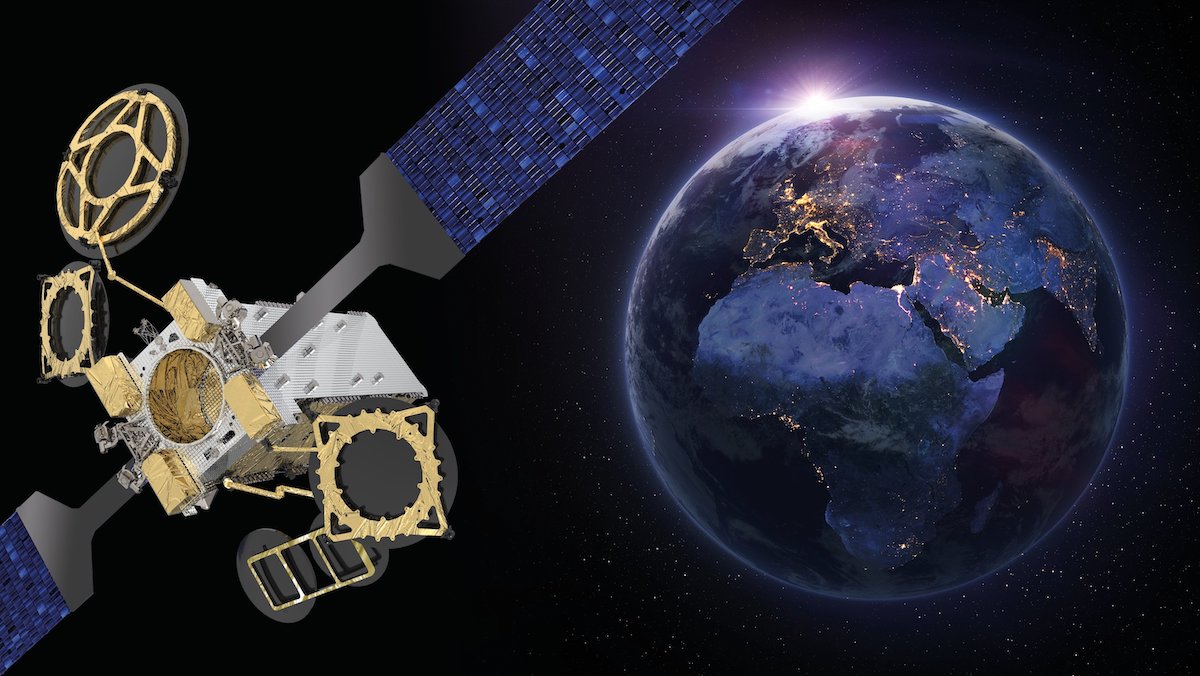
Despite a bleak weather forecast, SpaceX took advantage of a break in cloud cover over Cape Canaveral Tuesday night to launch a Falcon 9 rocket with the Eutelsat 10B satellite, a high-throughput relay platform to beam in-flight WiFi signals and maritime data services across a coverage zone from the North Atlantic to the Middle East.
The Falcon 9 rocket was powered by a first stage booster making its 11th and final flight. SpaceX did not attempt to recover the booster, giving Eutelsat 10B a ride to as high of an orbit as possible to speed up its entry into service next year.
SpaceX called off a launch attempt for the Eutelsat 10B mission Monday night to perform additional pre-flight checkouts. There was a 90% chance of unfavorable weather for Tuesday night’s launch opportunity, but conditions improved in time to allow the 229-foot-tall (70-meter) launcher to blast off from Cape Canaveral Space Force Station at 9:57 p.m. EST (0257 GMT).
The Falcon 9 climbed away from pad 40 with 1.7 million pounds of thrust, and soon soared into cloud cover as it arced downrange due east from Florida’s Space Coast. The rocket exceeded the speed of sound in about one minute, then shut down its nine Merlin main engines about 2 minutes and 43 seconds into the mission. The first stage fired its engines several seconds longer than a typical Falcon 9 mission, consuming all of its propellant and leaving no fuel reserve for landing.
Eutelsat and SpaceX agreed to expend the Falcon 9 booster, designated B1049 in SpaceX’s rocket fleet, to send the Eutelsat 10B satellite into a higher orbit. The booster was not fitted with landing legs or other recovery hardware. SpaceX still planned to recover the Falcon 9’s payload fairing with a ship dispatched far downrange from Cape Canaveral.
Liftoff of SpaceX’s Falcon 9 rocket with Eutelsat 10B, hauling a new broadband relay station to orbit to cover a region from the North Atlantic to the Middle East. https://t.co/ehXF7qW3Wg pic.twitter.com/inbPT977t7
— Spaceflight Now (@SpaceflightNow) November 23, 2022
The Falcon 9’s second stage engine fired two times to inject the Eutelsat 10B spacecraft into a “super synchronous” transfer orbit. The rocket deployed Eutelsat 10B as it flew over the Indian Ocean about 35-and-a-half minutes after liftoff, an event shown live by a camera on-board the Falcon 9.
U.S. military tracking data showed the rocket deployed Eutelsat 10B into a highly elliptical, or oval-shaped, orbit ranging between 162 miles and 37,177 miles in altitude (261-by-59,831 kilometers) at an inclination of 22.8 degrees to the equator. The orbit was close to pre-flight predictions.
Eutelsat 10B, built by Thales Alenia Space, will unfurl solar panels and use plasma thrusters to circularize its orbit about 22,000 miles (nearly 36,000 kilometers) over the equator, where it will circle Earth in lock-step with the planet’s rotation. The low-thrust but high-efficiency electric propulsion system will take several months to perform the orbit adjustments before Eutelsat 10B can enter service.
The satellite is owned by the Paris-based operator Eutelsat, which confirmed early Wednesday that ground teams completed a systems checkout of the spacecraft within a few hours after launch.
A spokesperson for Thales Alenia Space said the deployment of the satellite into a super synchronous transfer orbit will shorten the time needed for it to reach its final operational geostationary orbit by about 10 days. Based on Thales’ Spacebus Neo satellite platform, the satellite weighed about 5.5 metric tons, or more than 12,000 pounds, at the time of launch.
The expendable Falcon 9 mission Tuesday night marked the third time this month that SpaceX has disposed of a Falcon rocket booster, following the intentional disposals of a core stage on a Falcon Heavy rocket Nov. 1 and a Falcon 9 booster on a mission Nov. 12. The Nov. 12 mission lofted two communications satellites for Intelsat, which said it paid a premium for the extra performance from the Falcon 9, resulting in the booster’s disposal in the Atlantic Ocean.
A view of SpaceX’s Falcon 9 booster — tail number B1049 — completing its career with a good main engine cutoff and stage separation nearly three minutes after liftoff with the Eutelsat 10B satellite.
No booster recovery is planned tonight.
https://t.co/ehXF7qEsxG pic.twitter.com/nf0wB9q1dq— Spaceflight Now (@SpaceflightNow) November 23, 2022
“The reason why Eutelsat choose an expendable booster for this mission is because of the mass of the satellite, which requires the full capacity of fuel and extra performance of the Falcon 9 rocket and a proper orbit injection,” Pascal Homsy, Eutelsat’s chief technical officer, told Spaceflight Now in response to written questions.
Homsy declined to say how much, if anything, Eutelsat paid SpaceX for the additional performance from the Falcon 9 on the Eutelsat 10B mission.
Once in geostationary orbit next year, Eutelsat 10B will steer itself to an operating position along the equator at 10 degrees east longitude. The satellite will add capacity for internet connectivity services for airplanes and ships across the highly-trafficked North Atlantic corridor between Europe and North America. Eutelsat 10B will also provide similar services over Europe, the Mediterranean basin, and the Middle East, according to Eutelsat.
Eutelsat 10B carries two multi-beam high-throughout Ku-band payloads for aviation and maritime internet services. These two payloads have 116 spot beams capable of processing more than 50 GHz of bandwidth, and offering a throughout of approximately 35 gigabits per second, Eutelsat said.
The satellite also hosts two wide beam C-band and Ku-band payloads to extend services currently provided by the aging Eutelsat 10A satellite, which launched in 2009 and is expected to reach the end of its life in 2023.
Eutelsat 10B separation. A new satellite has deployed from SpaceX’s Falcon 9 rocket to begin a mission beaming in-flight WiFi and maritime communications services across the North Atlantic, Europe, the Mediterranean, Africa, and the Middle East. https://t.co/ehXF7qW3Wg pic.twitter.com/pAg65Vva6n
— Spaceflight Now (@SpaceflightNow) November 23, 2022
Eutelsat 10B is scheduled to enter service in the early summer of 2023, Homsy said.
The launch of Eutelsat 10B marks the fourth large Eutelsat communications satellite to launch in the last two-and-a-half months, beginning with the Eutelsat Konnect VHTS satellite which launched in September on an Ariane 5 rocket. Two Hotbird TV broadcasting satellites joined Eutelsat’s fleet after launches from Florida on Falcon 9 rockets in October and earlier this month.
“Quite a challenge for the Eutelsat engineering teams, who have been up to the challenge,” Homsy told Spaceflight Now.
“Eutelsat 10B’s Ku-band payload complements the Ka-band of the Eutelsat Konnect VHTS satellite, launched in September 2022, reflecting our ability to serve our customers in both Ka- and Ku-bands with the best-in-class space assets,” Homsy said in a Eutelsat press release.

The launch of Eutelsat 10B Tuesday night occurred about six hours after SpaceX scrubbed the launch attempt for a different Falcon 9 rocket at nearby Kennedy Space Center. The rocket was slated to launch a Dragon cargo ship to the International Space Station, but rainfall and thick clouds violated launch weather criteria.
The launch of SpaceX’s next space station resupply mission, named CRS-26, has been rescheduled for Saturday at 2:20 p.m. EST (1920 GMT).
Email the author.
Follow Stephen Clark on Twitter: @StephenClark1.
